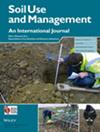The content and quality of soil carbon and nitrogen as well as enzymatic activity in soils with diverse texture following different land use and management practices
IF 3.7
3区 农林科学
Q1 SOIL SCIENCE
引用次数: 0
Abstract
A detailed knowledge concerning the responses of different carbon pools and the activity of soil enzymes to various land uses is critical for maintaining soil health and quality. Accordingly, the aim of this study was to determine the effects of different soil uses and management practices on the contents of total, dissolved and microbial biomass C and N as well as the fractional composition of humus and the set of enzyme activities. This study was conducted to compare the status of soil properties in the surface horizons of 24 soils with diverse textures, following the different land uses. Thus, arable lands, short‐term cultivation, vineyards, orchards, hop plantations and grasslands were compared. The contents of total and dissolved carbon and nitrogen, the fractional composition of humus, the content of microbial biomass C and N and the enzymatic activity were assessed. The application of various land uses affects the C and N content of the soils and their humus fractions as well as their enzymatic activities differently. Generally, both grass‐based systems (grasslands and orchards) revealed the most positive effects in most of the studied properties as compared to other land use systems. By contrast, long‐term tillage and/or the lack of permanent plant cover (cereals, grapevine and hop cultivation) adversely affects the studied properties of the soils. No clear pattern of changes was detected in terms of the fractional composition of the SOM. The enzymatic activity changed because of their different functions in SOM transformation and because of the differences in the complexities of the enzymatic substrates occurring in the soil. Most of the studied properties were significantly higher in soils with a loamy texture as compared to the sandy loam and loamy sand soils. Differently managed soils presented a distinctive response in terms of organic matter content and quality as well as extracellular enzyme activity as a function of the tillage regime applied and different cultivated plants. In general terms, both land uses which were based on permanent grass cultivation revealed that the most positive effects occurred on these studied properties as compared to other land use systems. Therefore, we may conclude that permanent grasslands play a special role in the status of soil organic matter, microbial content and enzymatic activity.不同土地利用和管理方法下不同质地土壤中的土壤碳、氮含量和质量以及酶活性
详细了解不同碳库和土壤酶的活性对各种土地利用的反应对于保持土壤健康和质量至关重要。因此,本研究的目的是确定不同的土壤用途和管理方法对总碳含量、溶解碳含量和微生物生物量碳和氮含量的影响,以及腐殖质成分和酶活性的影响。这项研究的目的是比较 24 种不同质地的土壤在不同土地用途下表层的土壤特性状况。因此,对耕地、短期种植、葡萄园、果园、啤酒花种植园和草地进行了比较。评估了总碳和溶解碳、氮的含量、腐殖质的比例组成、微生物生物量碳和氮的含量以及酶的活性。不同土地用途的应用对土壤的碳和氮含量、腐殖质组分及其酶活性的影响各不相同。一般来说,与其他土地利用系统相比,草地系统(草地和果园)对大多数研究属性都有最积极的影响。相比之下,长期耕作和/或缺乏永久性植物覆盖(谷物、葡萄和啤酒花种植)对所研究的土壤特性有不利影响。在 SOM 的部分组成方面,没有发现明显的变化模式。由于酶在 SOM 转化中的功能不同,以及土壤中酶底物的复杂性不同,酶的活性也发生了变化。与砂壤土和壤土相比,壤土质地土壤的大多数研究特性都明显较高。不同管理方式的土壤在有机质含量和质量以及胞外酶活性方面呈现出不同的反应,这与所采用的耕作制度和不同的栽培植物有关。总的来说,与其他土地利用系统相比,以永久性草地种植为基础的两种土地利用方式对这些研究属性产生了最积极的影响。因此,我们可以得出这样的结论:永久性草地在土壤有机质、微生物含量和酶活性方面发挥着特殊作用。
本文章由计算机程序翻译,如有差异,请以英文原文为准。
求助全文
约1分钟内获得全文
求助全文
来源期刊

Soil Use and Management
农林科学-土壤科学
CiteScore
7.70
自引率
13.20%
发文量
78
审稿时长
3 months
期刊介绍:
Soil Use and Management publishes in soil science, earth and environmental science, agricultural science, and engineering fields. The submitted papers should consider the underlying mechanisms governing the natural and anthropogenic processes which affect soil systems, and should inform policy makers and/or practitioners on the sustainable use and management of soil resources. Interdisciplinary studies, e.g. linking soil with climate change, biodiversity, global health, and the UN’s sustainable development goals, with strong novelty, wide implications, and unexpected outcomes are welcomed.
 求助内容:
求助内容: 应助结果提醒方式:
应助结果提醒方式:


